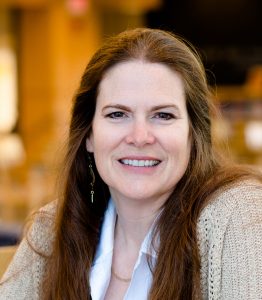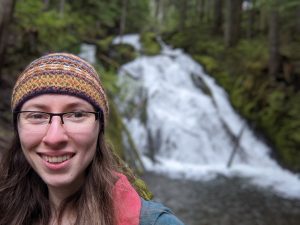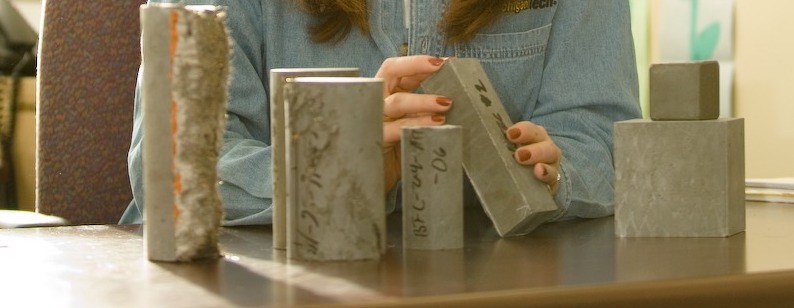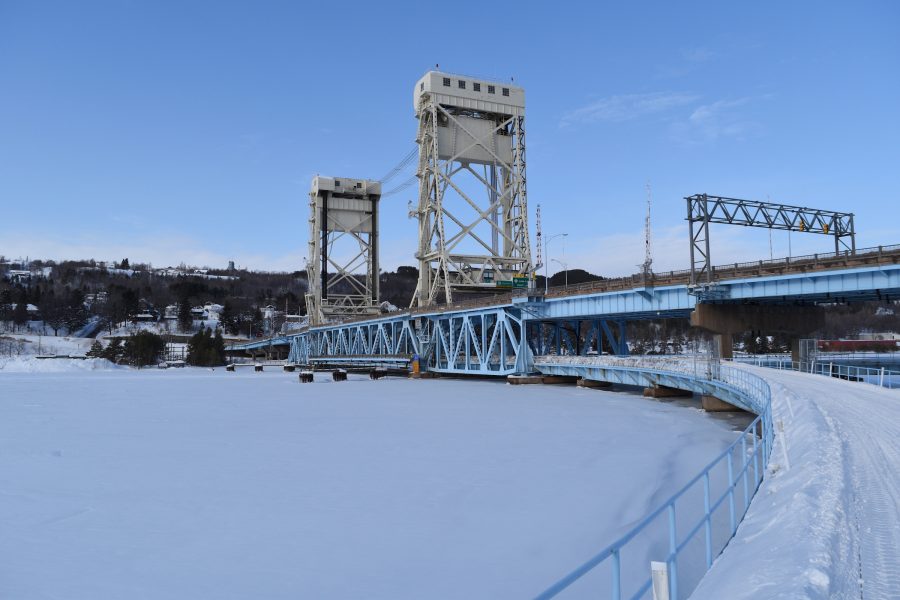
Tess Ahlborn shares her knowledge on Husky Bites, a free, interactive webinar this Monday, September 27 at 6 pm ET. Learn something new in just 20 minutes (or so), with time after for Q&A! Get the full scoop and register at mtu.edu/huskybites.

What are you doing for supper this Monday night 9/27 at 6 ET? Grab a bite with Dean Janet Callahan and Tess Ahlborn, Professor of Civil, Environmental, and Geospatial Engineering at Michigan Tech. The Portage Lake Bridge connecting Houghton and Hancock, Michigan, more commonly known as the Lift Bridge, was named as an ASCE National Historic Civil Engineering Landmark in late 2019 following a State Historic Landmark designation in 2018.
During Husky Bites we’ll hear about the wonders of the Lift Bridge from the very trio who submitted its 300-page application to the American Society of Civil Engineers (ASCE). Prof. Ahlborn will be joined by two of her former students, Michael Prast ’19, now a timber structural engineer at Fire Tower Engineered Timber in Calumet, Michigan; and Emma Beachy ‘19, a design engineer at Corbin Consulting in Portland, Oregon. Both earned both their BS and MS degrees in civil engineering at Michigan Tech.

We’ll learn about crossings prior to the current Lift Bridge, the people involved in designing and building the Lift Bridge, and what makes the Lift Bridge so unique to the region and the nation to proudly earn the National Landmark designation.
“Emma and Michael are two of Michigan Tech’s best students,” says Ahlborn. “I mentioned the topic of National Historic Landmarks during Bridge Design class, and let the class know I would be delighted if someone wanted to work on a nomination application for the Portage Lake Bridge. It didn’t take long for Emma and Michael to speak up, and the rest is history. I can’t thank them enough for taking on this project and seeing it through the application process!”

By the way, Prof. Ahlborn is a Michigan Tech alum, too. She earned her BS and MS at Michigan Tech, then went to University of Minnesota to earn a Doctorate of Philosophy in Civil Engineering in 1998. She’s been a member of the faculty at Michigan Tech for the past 26 years, teaching structural engineering courses focusing on concrete and the design of concrete buildings and bridges.
She has a passion for bridges, something that began when she was quite small. “Growing up, I once told my mom I loved bridges. After that, she started taking me to look at a different bridge each week. Michigan has such beautiful bridges!”
“Bridges are structural art! A piece of art fully exposed to the elements. They involve so many people every day.”
As the former Director of the Center for Structural Durability within the Michigan Tech Transportation Institute, Ahlborn has worked with the MDOT (Michigan Department of Transportation) and USDOT (US Department of Transportation) to seek solutions to improve the resiliency of our nation’s transportation infrastructure.
In 2020, Ahlborn was appointed to the American Concrete Institute Committee 318, placing her in the small group of people who establish the ACI structural concrete building code used around the world, a “Supreme Court” of concrete, if you will.

“It also means her peers consider her to be one of the most knowledgeable and trustworthy among them,” says Materials Science and Engineering Professor Larry Sutter, a concrete expert in his own right, as well as associate dean of research and external relations in the College of Engineering.
After water, concrete is the most widely used substance on the planet. As a member of the committee, Ahlborn helps to chart the future of structural concrete—its safety, sustainability, technological advances and environmental impacts.
“We think of concrete almost as rock, but a big part of it is the steel,” Ahlborn said. “It’s a frame of steel bars encased in concrete. People the world over need to know, ‘How do I design with it?’ and ‘How does it behave?’ The code is based on over 100 years of research.”
Ahlborn knows the code inside and out. As a civil engineering student at Michigan Tech, she learned ACI Code 318 from civil engineering professor Bogue Sandberg, now a professor emeritus. “Over the years I have taught at least 1,500 students in the classroom about the 318 code requirements,” she said.
As for her secrets to good teaching, she insists there aren’t any. “All you have to do is be fair and consistent and crack a joke once in a while,” said Ahlborn.
She invites alumni to speak to her classes, and she regularly brings in current news articles relating to the course, not to mention chunks of concrete with stories to tell. All together, “it helps the students understand why what they are learning is important.”
Ahlborn also serves as program director for all who seek a Michigan Tech online MS degree in Civil Engineering with a structural engineering focus. It’s a growing program, she says. “Most of our online graduate students are full-time working professionals taking one course per semester,” she says. “Every student’s program is tailored to their needs. They can obtain a full MSCE or a graduate certificate in, say, Structural Timber Design. It’s a great avenue for professionals to enhance their careers.”

Prof. Ahlborn, how did you first get into engineering? What sparked your interest?
As a young kid, I was always fascinated by bridges. It wasn’t until my high-school physics teacher asked me about my future plans. I was happy to report that I was applying to cosmetology schools, but I really liked bridges. After a few conversations, it was clear where I was heading: Civil Engineering. Soon enough, I jumped onto the structural engineering route and have loved working with bridges ever since!

Hometown?
Growing up in an all-American family in Kawkawlin, Michigan, followed by the real growing up as a student at Michigan Tech, I had the opportunity to watch the Zilwaukee bridge construction and land a dream job in the Minneapolis area designing dams, hydropower facilities, and bridges. When the engineering market slowed down, I jumped at the chance to complete a PhD. My husband, Mark, and I were blessed with twins, Jess and Jake, and chose the Keweenaw as the best place to settle down. I’m happy to share that we are now the proud grandparents of Charlie and Rory!
What do you do for fun?
I truly enjoy the outdoors and living in the Keweenaw, a very special place. Izzy, our Great Pyrenees, brings joy to our lives everyday and I love gardening, especially when she’s not running through the garden!

Michael, what first sparked your interest in engineering?
I’m originally from Holly, Michigan. I had a class in high school, Intro to Engineering, that went through some basics of the different engineering disciplines like electrical, computer modeling, and building. My favorite project was designing a balsa wood tower that was then compressed to failure. I really enjoyed it and my structure ended up being the most efficient in the class history comparing self weight to weight held. So I knew I wanted to do something with engineering and leaned towards buildings. I have been correct so far and love engineering a range of structures, mostly in heavy timber.
How do you like to spend your spare time?
While my favorite is mountain biking, I love to hike, camp, hammock, kayak, and swim. I also have a passion for history. I’m part of the volunteer board for Painesdale Mine and Shaft and give tours of the Champion Mine shaft house, hoist house, and Captain’s office.
Emma, how did you decide upon engineering?
I was born and raised in Madison, Wisconsin. For a long time I thought I wanted to be an architect, but then, during my senior year in high school, I took classes in Physics and Calculus. I absolutely loved them! After that, structural engineering felt like the perfect middle ground between architecture, and math and physics.

Hobbies?
My hobbies mostly revolve around the outdoors. Living in Oregon now, I’m lucky that I can drive a short ways and get to the Pacific coast (I love looking for tide pools) or to the mountains (I also love hiking and backpacking). At home, I really enjoy cooking. Lately I’ve been trying out some vegetarian recipes, trying out some new and interesting ingredients.